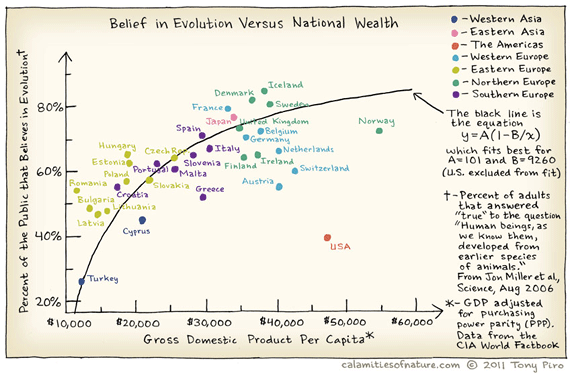by
Donald Prothero, Sep 12 2012

Compared to nearly every other industrialized country, our culture is abysmally illiterate in science. As I have pointed out in previous posts, we fall near the bottom of the developed nations in science literacy, among nations like Turkey with strong religious fundamentalist influences and a fraction of our spending on education. Many studies have shown that our science illiteracy begins partway through childhood, where kids go from excited about dinosaurs and astronomy and other topics when they begin school to way behind kids of other industrialized nations by the time they leave high school. A lot of different reasons have been suggested, but certainly we are fighting a rearguard action against a culture which values jocks and pop stars more than scientists or scholars. This is especially apparent in teen culture where science seems to move from “cool” to “nerdy” as soon as puberty kicks in. Then the social pressures seem to turn kids off, no matter how hard their high school science teachers work and try to keep their attention and interest. Continue reading…
comments (41)
by
Donald Prothero, Aug 29 2012

A Review of The Republican Brain: The Science of Why they Deny Science—and Reality by Chris Mooney, John Wiley, New York, 327 pages.
Reality has a well-known liberal bias.
—Stephen Colbert
Anti-intellectualism has been a constant thread winding its way through our political and cultural life, nurtured by the false notion that democracy means that ‘my ignorance is just as good as your knowledge’.
—Isaac Asimov
You can’t convince of believer of anything, for their belief is not based on evidence but on a deep-seated need to believe.
—Carl Sagan
Hearing the speakers at the GOP convention spout their ideas this week, I’m again reminded that an entire American political party is proudly and openly espousing views that are demonstrably contrary to reality, from claiming that rape does not cause pregnancy, to claiming that global climate change is a hoax, to even weirder idea, like the bizarre notion that the President of the United States is a Kenyan Muslim. For years, I’ve puzzled over why people can believe such weird things as creationism or other kinds of pseudoscience and science denials. In my 2007 book Evolution: What the Fossils Say and Why it Matters, I devoted an entire chapter to asking why creationists can so confidently believe patently false ideas, and refuse to look at any evidence placed in front of them. I’ve compared it to Alice’s Adventures Through the Looking Glass, where Alice steps through the mirror and finds that the objects and the landscape look vaguely familiar—but all the rules of logic are reversed or turned inside out. How can people continue to believe things that are clearly wrong, and refuse to change their ideas or look at evidence? Continue reading…
comments (125)
by
Donald Prothero, Jul 25 2012

Susanna Drury’s famous 1739 image, “A View of the Giant’s Causeway: East Prospect”
As we continually battle the efforts of creationists to tamper with science education in the U.S., and watch the dismaying polls that show about 40% of Americans agree with creationist positions, we try to take comfort in the fact that creationism has virtually no standing in most of Europe, which is also among the most secular regions in the world. Most attempts to push fundamentalist creationism in the more secular countries (especially those of northern Europe, including the Scandinavian countries, Germany, Holland, and the UK) have met with little or no success, and the number of creationists in those countries are minuscule. Even the predominantly Catholic parts of Europe don’t deal with much creationism, either, since the Catholic Church has long ago come to some sort of truce with evolution (although still reserving the right to make pronouncements about the soul and humanity’s animal nature). Nonetheless, even a small band of determined creationists can make a lot of trouble and influence policy way out of proportion to their numbers.
The latest controversy of this sort involves a famous geologic feature on the coast of County Antrim in northeastern Ireland known as Giant’s Causeway. Its discovery and description are important pieces in the early history of geology, as many different people in the 1700s puzzled over it and tried to explain it in the context of Noah’s flood, or gave even more fantastic explanations. There were numerous Irish legends about it. One account claims that Finn McCool (Fionn mac Cumhaill) built it as a bridge to Scotland to fight the legendary Scottish warrior Benandonner. According to different versions of the legend: Continue reading…
comments (27)
by
Donald Prothero, Jun 06 2012

This past year of electoral politics has been eye-opening in the United States, with GOP presidential candidates (especially Santorum, Perry, and Bachmann) openly advocating a Christian theocracy in this country, and many Republicans showing their scorn for the separation of Church and State (or rewriting history to diminish its importance). Only one (Jon Huntsman) of the original nine GOP candidates accepted evolution, and several were devout creationists (Bachmann got her start fighting for creationism in her local Minnesota school board). We’ve seen the Texas School Board not only pushing creationism, but dropping Thomas Jefferson from the list of “great Americans” because of his secularist views and low regard for established religion. Although the right wing in this country has always had a strong connection to evangelicals and fundamentalism, now they form one of the largest and most dedicated blocs in the GOP, so they dictate a national political stance that openly yearns for a Christian theocracy. Years ago, Barry Goldwater warned about them:
Mark my word, if and when these preachers get control of the [Republican] party, and they’re sure trying to do so, it’s going to be a terrible damn problem. Frankly, these people frighten me. Politics and governing demand compromise. But these Christians believe they are acting in the name of God, so they can’t and won’t compromise. I know, I’ve tried to deal with them. The religious factions that are growing throughout our land are not using their religious clout with wisdom…. I’m frankly sick and tired of the political preachers across this country telling me as a citizen that if I want to be a moral person, I must believe in ‘A,’ ‘B,’ ‘C,’ and ‘D.’ Just who do they think they are?… I will fight them every step of the way if they try to dictate their moral convictions to all Americans in the name of “conservatism.”
For the devil’s bargain that the GOP made back in the 1980s with Jerry Falwell and Oral Roberts and the rest of the evangelical megachurches and their preachers, now their pigeons have come home to roost. Barry would scarcely recognize today’s GOP. Continue reading…
comments (62)
by
Donald Prothero, May 09 2012
When you hear creationists argue their cause, sooner or later they reach into their standard litany of debunked arguments. One of their favorites (since it sounds convincing to their largely math-illiterate followers) is to point to the complexity of a molecular system or the cell or any other part of nature and “how could such a complicated system arise BY CHANCE?” The bigger implication is that they cannot fathom humans and their religious worldview being produced by anything other than a supernatural creator, so chance (as they misunderstand the concept) cannot produce it. The same argument underlies much of what the “intelligent design” creationists claim as well.
There are many versions of this argument, all of which are equally fallacious. When I debated Duane Gish at Purdue University in 1983, he was using his favorite line of his whole spiel, stolen from the maverick astronomer Fred Hoyle (legendary for being wrong on nearly every thing he argued, including Big Bang cosmology and his attacks on Archaeopteryx and evolution). In Gish’s version, he argues that the probability of random evolution assembling the complex system of life was as likely as a tornado in a junkyard assembling a Boeing 707 (which shows how ancient this punchline was).
Continue reading…
comments (30)
by
Donald Prothero, Feb 22 2012

“Pay no attention to that man behind the curtain”
—The Wizard of Oz
Having just suffered a major court defeat in 1987, the major players in the “Intelligent Design” creationism movement were trying to recover their momentum. They decided to transform and disguise their attacks on science by hiding their religious roots, and changing their creationist textbooks to remove overt references to God. They planned a subterfuge to get their unconstitutional dogmas taught in public schools in the form of “intelligent design” (ID), and claimed to be non-committal about the “designer” (even though every one of them was a devout evangelical Protestant, and open about their creationism when they spoke to religious groups). Behind the scenes, however, their intentions were very clear all along: drive a “wedge” of “intelligent design” to separate evolutionary biology and materialistic philosophy from its support in the United States, defeat not only evolutionary science but also materialism, and replace them with their own theistic dogmas. For public consumption, the ID creationists and the Discovery Institute in Seattle refused to admit that they were any more than scientists who wanted ID to get a legitimate chance of being heard and taught, since on the face of it they made no reference to a specific deity or designer.
But their cover was blown when a document which described their “wedge strategy” was leaked over the internet, and is now available to anyone who wants to read it. The “Wedge Document” describes their true intent: not new and important scientific research on evolutionary topics, but to win the battle by a concerted PR campaign to influence the public and political officials. Unlike all other legitimate scientific ideas that must pass muster of scientific peer review to persuade the scientific community that their approach was superior and truly scientific, the ID creationists planned an “end run” around the legitimate scientific community through PR and political pressure.
Continue reading…
comments (255)
by
Michael Shermer, Jan 31 2012
A couple weeks ago, I participated in an online debate at Evolution News & Views with Center for Science & Culture fellow Michael Flannery on the question: “If he were alive today, would evolutionary theory’s co-discoverer, Alfred Russel Wallace, be an intelligent design advocate?” The following is my opening statement in the debate. A link to Flannery’s reply can be found near the end of this page.
The double dangerous game of Whiggish What-if? history is on the table in this debate that inexorably invokes hindsight bias, along the lines of “Was Thomas Jefferson a racist because he had slaves?” Adjudicating historical belief and behavior with modern judicial scales is a fool’s errand that carries but one virtue—enlightenment of the past for correcting current misunderstandings. Thus I shall endeavor to enlighten modern thinkers on the perils of misjudging Alfred Russel Wallace as an Intelligent Design creationist, and at the same time reveal the fundamental flaw in both his evolutionary theory and that of this latest incarnation of creationism.
Wallace’s scientific heresy was first delivered in the April, 1869 issue of The Quarterly Review, in which he outlined what he saw as the failure of natural selection to explain the enlarged human brain (compared to apes), as well as the organs of speech, the hand, and the external form of the body:
In the brain of the lowest savages and, as far as we know, of the prehistoric races, we have an organ…little inferior in size and complexity to that of the highest types…. But the mental requirements of the lowest savages, such as the Australians or the Andaman Islanders, are very little above those of many animals. How then was an organ developed far beyond the needs of its possessor? Natural Selection could only have endowed the savage with a brain a little superior to that of an ape, whereas he actually possesses one but very little inferior to that of the average members of our learned societies.
(Please note the language that, were we to judge the man solely by his descriptors for indigenous peoples, would lead us to label Wallace a racist even though he was in his own time what we would today call a progressive liberal.) Continue reading…
comments (10)
by
Donald Prothero, Jan 11 2012

Consider the graph above (from the website Calamities of Nature). It shows the relationship between the acceptance of evolution (here defined as “humans beings, as we know them, evolved from earlier species of animals”, a reasonably good metric of true acceptance of evolution) in various countries around the world versus their relative wealth (as measured by GDP adjusted for Purchasing Power Parity). The main trend of countries form a well defined cloud with a reasonable curvilinear fit. At the top are a well-defined cluster of northern and western European nations (plus Japan), with the southern European nations just behind them. Near the bottom are the former Soviet bloc countries of eastern Europe, which still suffer the effects of decades of backward Soviet educational and economic policies. (China, South Korea, and Singapore are not shown, but on other surveys, they all rate high on the acceptance of evolution scale. so they would plot high on the ordinate or Y axis, no matter what their GDP).
The same relationship could be shown if you consider any of the recent surveys that measure science literacy on an international scale. The northern and western European nations (especially Germany and the Scandinavian countries plus Iceland) nearly always come out near the top, along with Japan, Singapore, South Korea, and sometimes China. The exact order differs from survey to survey, but they only shuffle within the top 10 or top 15. In other words, the acceptance of evolution in these countries is a very strong predictor of overall science literacy.
Now look at the position of the U.S. It is a striking outlier on the graph shown here, because its low rate of acceptance of evolution relative to its national wealth (and the same would be true if you plotted it against the money spent on education per student). It falls down near the bottom of the curve on evolution acceptance along with Islamic nations like Turkey, which spend much less per student. What is this telling us?
Continue reading…
comments (145)
by
Donald Prothero, Dec 14 2011
I have written frequently in these blogposts about the numerous forms of denial of science and reality that are out there, from global warming denialism, to AIDS denialism, anti-vaxxers, and creationism. They all have a lot in common, from their insular exclusionary attitude that refuses to accept evidence that doesn’t fit their world view, to the various strategies they use to reduce cognitive dissonance and fight against reality, all borrowed from the Holocaust deniers. These include: quoting out of context (“quote-mining”) to dishonestly suggest that the quoted person agrees with them, cherry-picking data to show the exact opposite of what the data really show, making phony lists of “experts” who agree with them, picking on the small differences within the scientific community as evidence that the “science is not settled”, picking on one small factoid (usually misinterpreted and out of context) as evidence that the whole of science is false, and so on. Usually, these obvious strategies to deny an overwhelming body of evidence are so transparently self-delusional that we can laugh at them.
 But then I ran into something that staggered even my sense of how low these people can go. We are all familiar with how creationists use ad hoc explanations and special pleading to rescue the absurdities of their world view, from trying to cram all of the animals into Noah’s ark and dismissing the huge numbers problem through their non-biological concept of “created kinds”, to doing all sorts of violence to the geologic record to justify the Noah’s flood story, to even insisting that men have one less rib than do women (the last one is easy to check, but they don’t). As I have discussed in several previous posts, the more extreme Biblical literalists also believe in a flat earth and reject the heliocentric solar system. But I was flabbergasted to read of a whole group of extreme creationists who deny that dinosaurs existed! Usually, the creationists not only come to terms with the evidence of dinosaurs, but many have even tried to co-opt their popularity with kids under 10 by making them a prominent part of their propaganda (as does Ken Ham of the “Answers in Genesis” ministry and the “Creation Museum” in Petersburg, Kentucky). With something as widely accepted and exciting and popular as dinosaurs, which anyone can see for themselves in their local museum, how could any person in the 21st century argue they are not real?
But then I ran into something that staggered even my sense of how low these people can go. We are all familiar with how creationists use ad hoc explanations and special pleading to rescue the absurdities of their world view, from trying to cram all of the animals into Noah’s ark and dismissing the huge numbers problem through their non-biological concept of “created kinds”, to doing all sorts of violence to the geologic record to justify the Noah’s flood story, to even insisting that men have one less rib than do women (the last one is easy to check, but they don’t). As I have discussed in several previous posts, the more extreme Biblical literalists also believe in a flat earth and reject the heliocentric solar system. But I was flabbergasted to read of a whole group of extreme creationists who deny that dinosaurs existed! Usually, the creationists not only come to terms with the evidence of dinosaurs, but many have even tried to co-opt their popularity with kids under 10 by making them a prominent part of their propaganda (as does Ken Ham of the “Answers in Genesis” ministry and the “Creation Museum” in Petersburg, Kentucky). With something as widely accepted and exciting and popular as dinosaurs, which anyone can see for themselves in their local museum, how could any person in the 21st century argue they are not real?
Continue reading…
comments (56)
by
Donald Prothero, Nov 30 2011
People love to touch old objects and feel a connection to the past, whether it be the Wailing Wall in Jerusalem, ancient ruins in China or India or Egypt or Europe, pieces of fossil bone on display in a museum, or the oldest objects known, the 4.6 billion-year-old meteorites. Each time I travel to do research in historic old museum collections, it feels a bit like time travel. In my field, the original specimens first described by the founders of my profession, 19th-century paleontologists like Edward Drinker Cope, O.C. Marsh, and Joseph Leidy, are still essential parts of our research. We must examine these “type specimens” to determine whether fossil species these people named and described over 100 years ago are still valid today, when we have much better and more complete and abundant specimens. When I visit the Academy of Natural Sciences in Philadelphia, I can examine type specimens first named by Leidy in the 1850s. At Yale, nearly every specimen I looked at was first studied by Marsh in the 1870s and 1880s. At the American Museum of Natural History in New York, I worked not only on fossils first studied by Cope in the 1870s and 1880s, but the Osborn Research Library in the Department of Paleontology even has Cope’s geology pick where any visiting scientist can touch it, or one can sit down at Cope’s original desk. Cope’s skull (donated to science, along with his entire skeleton) has floated around various museums, and many paleontologists have handled it as well (with lots of jokes about the odd situation).
Vertebrate paleontology is also such a small profession with so few practitioners in its mere 150 years of existence that we’re all connected by our graduate advisors to just a handful of men who founded the profession over a century ago. When I was a student, I shook the hand of Ned Colbert, who was Henry Fairfield Osborn’s assistant in the 1920s, and Osborn bragged that he had shaken both Darwin’s and Huxley’s hand when he did post-graduate study in Europe. So I’m only 3 degrees of separation from Darwin himself. (I also have a friend who was in the cast of the original “Footloose”, so I’m 2 degrees from Kevin Bacon).
When I visited the American Museum this fall to continue my research on fossil peccaries or javelinas (American pig-like creatures only distantly related to Old World pigs), I was keeping a close watch for one specimen in particular. Everyone who has fought in the evolution-creation wars has heard of it, and I wanted to finally see and touch the specimen for myself. It is the tooth that caused a sensation in the 1920s, and has since become something that creationists harp on excessively, even though their version of the story is full of lies and myths. It is the tooth known as Hesperopithecus haroldcooki (“Harold Cook’s western ape”). Continue reading…
comments (25)








